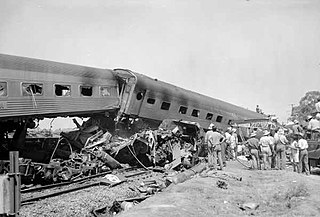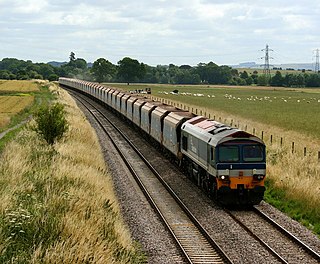
The Violet Town rail accident, also known as the Southern Aurora disaster, was a railway accident that occurred on 7 February 1969 following the incapacitation of the driver of one of the trains, near the McDiarmids Road crossing, approximately 1 km south of Violet Town, Victoria, Australia. The crash resulted in nine deaths and 117 injuries.

The Southall rail crash occurred on 19 September 1997, on the Great Western Main Line at Southall, West London. An InterCity 125 high speed passenger train (HST) failed to slow down in response to warning signals and collided with a freight train crossing its path, causing seven deaths and 139 injuries.
The Charfield railway disaster was a fatal train crash which occurred on 13 October 1928 in the village of Charfield in the English county of Gloucestershire. The London, Midland and Scottish Railway (LMS) Leeds to Bristol night mail train failed to stop at the signals protecting the down refuge siding at Charfield railway station. The weather was misty, but there was not a sufficiently thick fog for the signalman at Charfield to employ fog signalmen. A freight train was in the process of being shunted from the down main line to the siding, and another train of empty goods wagons was passing through the station from the Bristol (up) direction.

The Chester General rail crash occurred on 8 May 1972 at Chester, northwest England, resulting in extensive fire damage, but no casualties. It was caused by brake failure through human error.

Mendip Rail Ltd is an independent freight operating railway company in Great Britain. It is a joint venture composed of the rail-operation divisions of Aggregate Industries and Hanson Aggregates.

Over the latter years of the 19th and early years of the 20th centuries, Penistone in Yorkshire gained a name as an accident black-spot on Britain's railway network; indeed, it could be said to hold the title of the worst accident black-spot in the country. The main line through the town was the Woodhead route of the Manchester, Sheffield and Lincolnshire Railway between Sheffield Victoria and Manchester, London Road. The line was heavily graded with a summit some 400 yards inside the eastern portal of the Woodhead tunnel.
There have been a number of train accidents on the railway network of Victoria, Australia. Some of these are listed below.
The railways of New South Wales, Australia have had many incidents and accidents since their formation in 1831. There are close to 1000 names associated with rail-related deaths in NSW on the walls of the Australian Railway Monument in Werris Creek. Those killed were all employees of various NSW railways. The details below include deaths of employees and the general public.
The Wrawby Junction rail crash was a train crash which occurred on 9 December 1983, at Wrawby Junction, near Barnetby station, North Lincolnshire, England.

Great Western Railway accidents include several notable incidents that influenced rail safety in the United Kingdom.

The Knowle and Dorridge rail crash was a fatal rail crash that occurred at Dorridge railway station in the West Midlands, England, on 15 August 1963. Three people died in the crash after a signalman's error routed a small freight train into the path of an express passenger train which slowed but could not stop before colliding with it.
The Settle rail crash was a railway accident that occurred at Langcliffe near Settle, England, on the night of 21 January 1960 in which two trains collided, killing five people and injuring eight more.
Rednal rail crash was a rail accident that occurred near Rednal station in Shropshire.
This article lists significant fatal, injury-only, and other accidents involving railway rolling stock, including crashes, fires and other incidents in the Australian state of South Australia. The first known incident in this list occurred in 1873 in Smithfield, South Australia.







